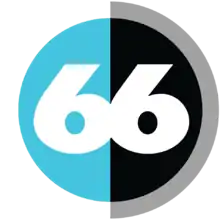XHILA-TDT
XHILA-TDT (channel 66) is a Spanish-language independent television station in Mexicali, Baja California, Mexico, serving the Mexicali Valley and the southern Imperial Valley, including El Centro, California, and the Colorado River cities of San Luis Río Colorado, Sonora, and Yuma, Arizona. The station is also carried on the cable television systems of each of the four principal communities it serves.
 | |
| |
|---|---|
| City | Mexicali, Baja California |
| Channels | |
| Branding | El Canal de las Noticias (The News Channel) |
| Programming | |
| Affiliations | 66.1: Canal 66 (2015–present) 66.2: Canal Catorce 66.3: 2 hour delay of 66.1 66.4: Milenio Television |
| Ownership | |
| Owner |
|
| History | |
| Founded | 1997 |
First air date | October 1998 |
Former call signs | XHILA-TV (1998–2013) |
Former channel number(s) | Analog: 66 (UHF, 1998–2013) Digital: 46 (UHF, until 2018) |
| CNI (to 2005) cadenatres (until 2015) | |
| Technical information | |
Licensing authority | IFT |
| ERP | 107.490 kW |
| Translator(s) | K07ZF/K29LS-D (Calexico, California) K33MD-D (Yuma, Arizona) (owned by Broadcast Group, Ltd.) |
| Links | |
| Website | www |
Taking to air in October 1998, the station is owned by Intermedia de Mexicali, a subsidiary of the Ciudad Juárez-based Grupo Intermedia and is licensed to its president, Arnoldo Cabada de la O.[2]
History

XHILA-TV began with experimental broadcasts in 1997, then began broadcasting commercially in October 1998.[3] It has been owned since its inception by Intermedia de Mexicali, airing independent programming during the day, and (originally) news from CNI at night.
In 2008, XHILA became affiliated with Mexico's newest broadcast network, cadenatres.
Programming
XHILA-TDT targets both sides of the U.S.–Mexican border. XHILA-TDT provides local information, news shows and variety programs for viewers along with a schedule of movies, comedies and programs of interest.
In 2015, Intermedia signed a contract with the Sistema Público de Radiodifusión del Estado Mexicano to carry its Una Voz con Todos network on its stations in Mexicali and Ciudad Juárez. This marks the first time that Mexicali has ever had national public television service.
Technical information
Subchannels
The station's digital signal is multiplexed:
| Channel | Res. | Aspect | Short name | Programming |
|---|---|---|---|---|
| 66.1 | 1080i | 16:9 | XHILA | Main XHILA-TDT programming |
| 66.2 | 480i | 4:3 | Canal Catorce | |
| 66.3 | 16:9 | 2 hour delay of 66.1 | ||
| 66.4 | 4:3 | Milenio Televisión |
Analog shutdown
Under Mexican law, XHILA would have been required to turn off its analog signal on November 26, 2013 (a date that has since been postponed), but XHILA opted to switch early, seeking and winning approval from Cofetel to shut down early.[4]
On March 6, 2013 at 11:30 p.m., XHILA turned off its analog signal. It was the first television station in Mexicali to do so and the second in Mexico, after XHUNAM-TDT went digital-only in 2005.
In March 2018, in order to facilitate the repacking of TV services out of the 600 MHz band (channels 38-51), XHILA was assigned channel 20 for continued digital operations, however, the station did not perform the repack until November 27,[5] making it the last station in Mexicali to do so after XHBC-TDT, XHMEX-TDT and XHMEE-TDT repacked in July 2017.
U.S. translators
Broadcast Group, Ltd., an American company which is controlled by the Cabada family, owns two translators in the United States that relay XHILA.
In Yuma, the analog translator was low-powered K28FM. At various times in its history, it was affiliated with musical networks such as Más Música and MTV Tr3s, and at others it rebroadcast XHILA. K28FM, in effect, was the first American affiliate of cadenatres as it relayed XHILA when it took on the affiliation in 2008. In the late 2000s, K28FM went silent; in 2015, K33MD-D, a digital translator also owned by Broadcast Group, was put into service.[6] The license for K28FM was cancelled by the Federal Communications Commission on July 19, 2021.
In Calexico, K07ZF channel 7 was the analog translator. Given that the digital transition of XHILA's Mexicali transmitter led to a loss of viewership, channel 7 was promoted as XHILA's analog channel. In 2015, K42KZ-D, also owned by Broadcast Group, was signed on.
Both the Yuma and Calexico transmitters relay XHILA, including all of its subchannels.
K42KZ-D was assigned channel 29 in order to clear the 600 MHz band, and became K29LS-D effective November 3, 2021.
References
- Instituto Federal de Telecomunicaciones. Listado de Canales Virtuales. Last modified December 21, 2021. Retrieved December 2, 2020.
- Instituto Federal de Telecomunicaciones. Infraestructura de Estaciones de TDT. Last modified 2018-05-16. Retrieved 2014-07-02. Technical information from the IFT Coverage Viewer.
- "Corporativo". Canal66.com.mx. Archived from the original on February 21, 2013. Retrieved 2007-09-21.
- Cofetel autoriza adelantar apagón a televisora en Mexicali Diario EL Universal Online, February 6, 2013 at 7:02 PM, viewed in February 8, 2013 at 10:14 p.m.
- "Canal 66 el Canal de las Noticias - #AlMomento #Canal66 Reprograme su televisor 📺 estamos al aire canal 66 a través del canal 20 Seguimos siendo #Canal66 pero a través de la señal del canal 20. | Facebook".
- "Lanzó familia Cabada canal 33 en Yuma Arizona - YouTube". YouTube.
External links
- Station website
- Facility details for Facility ID 185530 (K29LS-D) in the FCC Licensing and Management System
- Facility details for Facility ID 188113 (K33MD-D) in the FCC Licensing and Management System